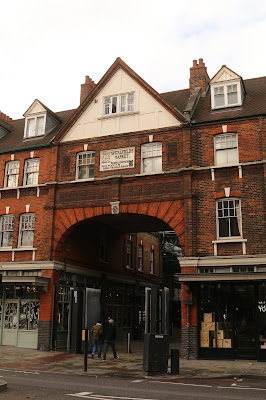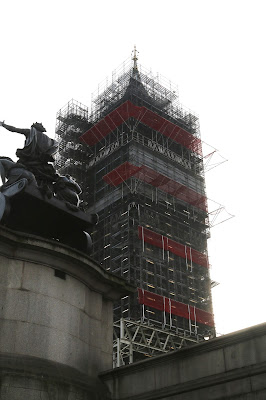Day 5 Petticoat Lane Market, Spitalfields Market, Brick Lane Market and Westminster At War -
Up and at um with our first stop at Petticoat Lane Market. Petticoat Lane is billed as London's world famous Sunday market where mainly clothes for men, women and children are found. One of its specialities is leather wear and there's limited bric-a-brac. The market is held in and around Middlesex Street on Sundays from 9am to 3pm, with a smaller market open on Wentworth Street from Monday to Friday. Confusingly, Petticoat Lane doesn't actually exist any more - we have the Victorians' prudishness to thank for that. Wishing to avoid any reference to undergarments, they changed the name to Middlesex Street in 1846. We were a tad confused when looking at maps to navigate to this market. With more than 1,000 stalls lining the streets on a Sunday, bargain hunters come in droves, it's a great scene worth the trip even if you're not shopping.
Old Spitalfields Market is one of the finest surviving Victorian Market Halls in London (built 1876). Here one finds stalls selling antiques, food and fashion, varying from distinct and quirky creations from up-and-coming designers to bohemian, vintage and African designs. Boutiques offer everything from hand-crafted wooden toys to today's design items.
Here is the Ten Bells Pub for you Ripper Fans
Pretty darn Kewl Smoker
Custard Tarts and Doughnuts
There mix of well-known chain restaurants and fresh food market stalls to provide a gastronomic paradise for discerning food lovers and families alike. High quality and affordable cuisine on offer includes deli-style dishes, fresh produce, artisan breads and plenty of organic and fair trade products.
Here we found the Big Doughnut stall selling a custard tarts and cream filled doughnuts. We split a custard tart as we chatted with the gentleman manning the stall. He told us he had been working this stall since he was 14 yeas old and I would guess he was in his mid to late 20’s. For him this is a side job as his trade is that of a plumber. We thought his custard tarts were great.
We were early and walked about as many vendors were setting up their stalls.
From Old Spitalfields Market, we made our way a few blocks to the Brick Lane Market. This quickly became my favorite market, as there was an earthy everyday-man atmosphere.
Brick Lane is not just a market and it is more than just one street. It is a network of covered markets and streets, that make up the bustling atmosphere of Brick Lane. Here one can delve deep into the East London Lifestyle. The food offerings here vastly out number those found in other markets we have visited. This market was void of the tourist vail and has a working man’s air.
I can not even start, nor can I finish, a list of the food offerings, we saw Chicago Hot Dogs, many many different styles of Asian food, Africa and the Caribbean are represented, sausages from everywhere, and the list goes on and on.
We did stop for a pork bap from “Pigling Street”. The pork they use is a unique free range breed of pig which is raised on one farm in Blythburgh. THIS WAS EXCELLENT!!!
Lynn had a duck egg sandwich
Wonderful Pork
Beautiful Free Range Pork
Pickles and cabbage
A bit of lettuce
Finished product, EXCELLENT
We then went to the Sherlock Holmes pub for an afternoon break, before our London Walks “Westminster At War”.
When walking about London you might notice these Blue Plaques telling of who lived where. One never knows what they will find.
We met the London Walks guide, Steven, at the Embankment Station and were soon off to Cleopatra’s Needle, the Egyptian Obelisk, to view pockmarks created by shrapnel during
WWII.
Steven’s delivery and knowledge made this walk most enjoyable as he related his mothers experiences during the Second World War.
We observed the Waterloo Bridge and learned that due to WWII and the working men headed to war, the bridge was 85% completed by women workers.
The Docklands area was hit hard during the Blitz as it was a center for the arrival of goods both for the war effort as well as supplies for the daily life of those in England. The workers were not afforded the Air Raid Shelters others had been given, so in September of 1940 they came and protested at the POSH Savoy Hotel. During this protest there was an air raid and the protesters were given shelter. They greatly appreciated the service and shelter and even tipped their hosts as the all clear was sounded. This did lead to more shelters being build for the Docklands area.
Next to the Savoy, where the Cecil Hotel once stood, we found a plaque commemorating the founding of the RAF in1918.
It was during The Blitz that Noel Coward would perform at the shelter in the Savoy. For this service he was thanked with complimentary suites for his visits to London. All he needed to do was make a call and a suite was readied for him.
If one remembers reading about one famous correspondent of WWII named Ed R. Marrow (he and Walter Cronkite covered the Nuremberg trials), he would interview Londoners on the street. The Londoners would end the conversation by saying “Good Night and Good Luck”. It is from these interviews Marrow gained his famous sign off line.
Franklin of the Franklin Expedition, soon to be a TV show called The Terror.
A German Grave join London, yes it is the grave of the German Ambassadors dog. Ciro was his name and may he RIP.
Sadly, during The Blitz, crime was rampant. There was a greatly reduced police force and the Black outs and bombings made for great opportunities for the criminals. Looting of bombed out houses and theft from the bodies of victims was not uncommon. These events and the detailed news of the bombing were censored for the British Press. Yet the American Press was able to tell of the bombing in much more detail. I feel this was to maintain calm in the UK and to fire up the Americans to come to the aid of the UK.
Interestingly, the China Town area of London, used to be where the Italian immigrates lived. Italy was allied with Germany and the Italians became suspect. The Italians were moved out of their residences and the Chinese workers from the Docklands moved in and today this is still the London China Town area.
While The Blitz was from air ships and planes, there was also the V-I and V-II missiles. The V-I, known as the doodlebug by the English, was simply a slow moving rocket launched from a launching ramp. The V-I could be shot down by fighter aircraft as they were that slow. It was not specifically aimed, just fired in the direction of the UK and when it ran out of fuel it dropped as a bomb. As the war progressed and the European Continent was invaded, the Allied armies over took the V-I launching ramps. The Allies soon realized the only way to stop the V-II was to destroy the manufacturing plants. Hence this was a priority target for the Allied bombing missions.
This was a very informative walk. I have just touched on some of the highlights. I will finish with that the rationing of goods interesting continued in one form or another, till 1953.
After the walk we made our way back to Westminster Pier and boarded the Water Bus to take us to Tower Bridge where we caught the DLR back to our Hotel.
Peace Officer Memorial
Look at all the phone cameras and these Horses kept getting in my way as I wanted a photo of the Phone People :)
LOOK KIDS BIG SCAFFOLDING !!!
Lynn getting ready to board our evening pre dinner cruise. :)
As it is the last day of National Pie Week, we went international and had a Pizza Pie here at the Hotel Lounge. It was rather good.
To borrow the words of Edward R. Murrow “Good Night and Good Luck”.


































Scott. Thank you for such a great commentary of your day. Wishing the two of you the best of this trip!!
ReplyDelete